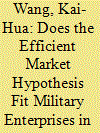| Srl | Item |
| 1 |
ID:
120080


|
|
|
|
|
| Publication |
2012.
|
| Summary/Abstract |
This article examines as to whether past stock prices in the Colombo Securities Exchange (CSE) exhibit predictability of future prices by using various statistical tests for the period from 1985 to 2009 on daily data. The findings of various statistical tests generated mixed results. The results of tests on serial correlation, runs test, variance ratio test and tests on the day-of-the-week effect rejected the weak-form of Efficient Market Hypothesis, whereas Augmented Dickey-Fuller (ADF) test and Phillips Perron (PP) unit root tests as well as the month-of-the-year test failed to reject the presence of random walk. Findings of the ADF and PP test statistics implied that daily changes in stock prices cannot be predicted, so that no investor can earn abnormal profits by exploiting past stock price patterns. This indicates the presence of weak-form efficiency in CSE. However, the results of serial correlation tests, runs test and variance ratio test imply that prices of ASPI do not reflect past prices, indicating that future movements of the stock prices can be predicted by using past price movements. The idea that past price information can only partially predict the future movements of prices/returns indicates that other information is also vital in changing stock prices/returns. The article concludes that the weak-form inefficiency is the normal situation in the CSE.
|
|
|
|
|
|
|
|
|
|
|
|
|
|
|
|
| 2 |
ID:
170222


|
|
|
|
|
| Summary/Abstract |
This paper investigates whether the efficient market hypothesis (EMH) fits the Chinese military market using the Sequential Panel Selection Method (SPSM) and the Panel KSS unit root test with a Fourier function. We obtain evidence for structural shifts and non-linearity in the stock prices of the military industry in the Chinese stock market. Because sharp shifts and structural breaks are taken into account, the unit root hypothesis for most listed companies is rejected. Our result suggests that the Chinese military market is inefficient because of such factors as defense reforms, friction in the stock market, and irrational investors. We provide investment implications to enable future stock price movements to be predicted based on past behavior and enable trading strategies to be developed to earn abnormal returns. Meanwhile, Chinese defense enterprises should continue to implement industrial reforms, change their bureaucratic culture, and develop a market-oriented workforce.
|
|
|
|
|
|
|
|
|
|
|
|
|
|
|
|
| 3 |
ID:
110254


|
|
|
|
|
| Publication |
2012.
|
| Summary/Abstract |
Groenewold et al. (2004) documented that the Chinese stock market is inefficient. In this paper, we revisit the efficiency problem of the Chinese stock market using time-series model based trading rules. Our paper distinguishes itself from previous studies in several aspects. First, while previous studies concentrate on the viability of linear forecasting techniques, we evaluate the profitability of the forecasts of the self-exciting threshold autoregressive model (SETAR), and compare it with the conventional linear AR and MA trading rules. Second, the findings of market inefficiency in earlier studies mainly rest on the statistical significance of the autocorrelation or regression coefficients. In contrast, this paper directly examines the profitability of various trading rules. Third, our sample covers an extensive period of 1991-2010. Sub-sample analysis shows that positive returns mainly concentrate in the pre-SOE reform period, suggesting that China's stock market has become more efficient after the reform.
|
|
|
|
|
|
|
|
|
|
|
|
|
|
|
|